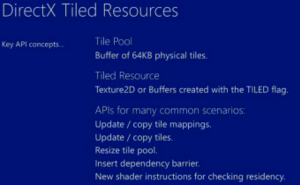

#Hardware tiled resources tier 2 drivers
Please ensure you have a directX 12 compatible graphics adapter and have installed the latest drivers provided by the manufacturer.' 16GB of ram GTX Titan Black with 6 VRAM Intel (R) Core (TM) i5-7400 CPU 3. By doing this games can eliminate the unnecessary bandwidth and memory consumption which frees up resources for more important things. 'Could not find compatible graphics device due to the following missing feature: Hardware tiled Resources Tier 2. Instead of requiring games to stream and allocate memory for an entire resource, games can “virtually” allocate the resource, and only associate a few regions (“pages”) with actual physical memory. DirectX11.2 enables native hardware support for virtual texturing through tiled resources. What if a game could avoid wasting this memory and bandwidth and instead just use the texel data it needs to render a frame? This is where GPU page tables provide an answer. 'Could not find compatible Graphics Device due to the following missing feature: Hardware Tiled Resources Tier 2.

In this scenario memory is wasted and bandwidth as well. A tabletop, for example, might have a size of 4096×2048, over 10 million texels after MIP mapping! And traditionally, games have had to reserve all that memory even though they’ll never actually need all of it to render a single frame! In addition, if games wanted to stream this texture data to the GPU they had to upload an entire MIP level at once.

That’s not a whole lot of memory, but in a real game the texture would be much larger. Note: The rendering performance is "faster" than in compatibility mode, although switching or spanning displays may result in minor transient rendering artifacts.Overall, this texture would use 21 texels worth of memory. When this mode is in effect, OpenGL renders in "performance" mode for all displays and when different classes of GPUs are in use, the lowest common feature set of all active GPUs is exposed to OpenGL applications. Built on the 28 nm process, and based on the GK110B graphics processor, in its GK110-430-B1 variant, the card supports DirectX 12. Multi-display performance mode is useful if you have two or more active displays when running in nView Dualview mode or if you are using different classes of NVIDIA GPU-based cards. Per Techpowerup: The GeForce GTX TITAN BLACK was an enthusiast-class graphics card by NVIDIA, launched on February 18th, 2014. Note: The OpenGL rendering performance is slightly "slower" than in single-display mode.

When this mode is in effect, OpenGL renders in "compatibility" mode for all displays so that when different classes of GPUs are in use, the lowest common feature set of all active GPUs is exposed to OpenGL applications. Note: This mode is faster than either of the multi-display modes described below.Ĭ ompatibility performance mode is useful if you have two or more active displays when running in nView Dualview display mode or if you are using different classes of NVIDIA GPU-based graphics cards. In Hardware Tiled Resources Tier 2, we examined the important focuses to assist the clients with working on the visual capacity of the PC. Single-display performance mode: Specify this setting if you have problems with the multi-display modes. Under Settings, click the setting corresponding to the Multi-display/mixed-GPU acceleration feature and select one of these options: The options on this "advanced" page enable you to change all the image and rendering settings of your 3D applications that utilize Direct3D and OpenGL technology. From the NVIDIA Control Panel navigation tree pane, under 3D Settings, select Manage 3D Settings to open the associated page.


 0 kommentar(er)
0 kommentar(er)
